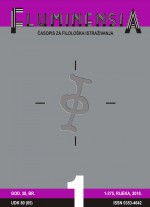CONTRIBUTION TO THE LEXICAL ANALYSIS OF THE TRSAT STATUTE
Keywords:
Trsat statute, statute, terms of Croatian origin, terms of foreign origin, loanwords, Croatian languageAbstract
Legal documents such as laws, bylaws and statutes have played an important role in the history of the Croatian language and bear testimony to the process through which language has developed over centuries. Moreover, historical legal documents contribute to the research of Croatian grammar and enable us to gain insight into early Croatian idioms. The analyses of Croatian historical texts usually focus on the scripts used to record them and on the morphological and the phonological layer. Less attention is paid to the lexis of the analyzed texts. Hence, the purpose of this article is to analyze the lexical segmentation of the Trsat Statute with an emphasis on its terminological features. In addition to this, the article will demonstrate the impact of foreign languages on the lexis of the Trsat Statute. The Statute’s lexical elements are grouped according to their origin and according to the typical semantic fields to which particular lexemes belong.
Since it is a legal document, the Statute mainly contains terms such as those that belong to the legal, ecclesiastical and military domains. The terminology is characterized by numerous expressions of foreign origin or loanwords, due to the deficiency of the corresponding Croatian expressions and to the interference and influence of the neighborly Italian and German languages, with the inevitable impact of Latin and occasional examples from other languages that have influenced the Croatian language. Words of Roman origin are more numerous than those of Germanic, since the territory on which the Trsat Statute was created was under Venetian (Italian) supervision, and not German.
Lexical analysis of the Trsat Statute vindicates a remarkable skill in the systematization of legal customs, even though the level of the development of Croatian terminology at that time was quite modest. The use of foreign terminology, alongside Croatian synonyms, signals the author’s awareness of this fact and of the need to replace foreign terms with native ones. At the same time, the author enters deeper into linguistic history. In this way we come across numerous Proto-Slavic terms which can be found in other Slavic countries’ legal texts. In addition to this, a small number of terms of Croatian, that is, Slavic, origin testify to an aspiration towards creating Croatian terminology. The analysis of the Trsat Statute indicates that the statutes of Croatian cities and municipalities represent not only historic, but also extremely important linguistic sources.

